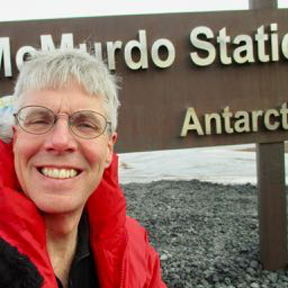Affiliate
email: springer (at) esr.org
 https://orcid.org/0000-0002-6669-4557
https://orcid.org/0000-0002-6669-4557
Research focus: Polar oceanography and modeling
Current Research Projects:
Publications
For more information, see Scott Springer on Google Scholar.
ACCEPTED and IN PRESS
Klein, E., Mosbeux, C, Bromirski, P. D., Padman, L., Bock, Y., Springer, S. R., and Fricker, H. A. (2020). Seasonal cycle in flow of Ross Ice Shelf, Antarctica, driven by basal melting, Journal of Glaciology.
PUBLISHED Porter, D. F., Springer, S. R., Padman, L., Fricker, H. A., Tinto, K. J., Riser, S. C., Bell. R. E. , and the ROSETTA-Ice Team (2019), Evolution of the seasonal surface mixed layer of the Ross Sea, Antarctica, observed with autonomous profiling floats, Journal of Geophysical Research – Oceans, 124 (7), 4924-4953, DOI:10.1029/2018JC014683. Journal Version K. J. Tinto, L. Padman, C. S. Siddoway, S. R. Springer, H. A. Fricker, I. Das, F. Caratori Tontini, D. F. Porter, N. P. Frearson, S. L. Howard, M. R. Siegfried, C. Mosbeux, M. K. Becker, C. Bertinato, A. Boghosian, N. Brady, B. L. Burton, W. Chu, S. I. Cordero, T. Dhakal, L. Dong, C. D. Gustafson, S. Keeshin, C. Locke, A. Lockett, G. O’Brien, J. J. Spergel, S. E. Starke, M. Tankersley, M. G. Wearing, R. E. Bell (2019), Ross Ice Shelf response to climate driven by the tectonic imprint on seafloor bathymetry, Nature Geoscience, doi: 10.1038/s41561-019-0370-2 Journal Version Arzeno, I., R. C. Beardsley, R. Limeburner, B. Owens, L. Padman, S. R. Springer, C. L. Stewart, and M. J. M. Williams (2014), Ocean variability contributing to basal melt rate near the ice front of Ross Ice Shelf, Antarctica, J. Geophys. Res. Oceans, 119, 4214-4233, doi:10.1002/2014JC009792. Journal Version Marques, G. M., L. Padman, S. R. Springer, S. L. Howard, and T. M. Özgökmen (2014), Topographic vorticity waves forced by Antarctic dense shelf water outflows, Geophys. Res. Lett., 41, 1247-1254, doi:10.1002/2013GL059153. Marcott, S. A., P. U. Clark, L. Padman, G. P. Klinkhammer, S. R. Springer, Z. Liu, B. L. Otto-Bliesner, A. E. Carlson, A. Ungerer, J. Padman, F. He, J. Cheng, and A. Schmittner (2011), Ice-shelf collapse from subsurface warming as a trigger for Heinrich events, PNAS, 108 (33) 13415-13419, doi:10.1073/pnas.1104772108. de Szoeke, R. A. and S. R. Springer (2009), The materiality and neutrality of neutral density and orthobaric density, Journal of Physical Oceanography 39(8), doi: 10.1175/2009JPO4042.1 Springer, S. R., R. M. Samelson, J. S. Allen, G. D. Egbert, A. L. Kurapov, R. N. Miller, and J. C. Kindle (2009), A nested grid model of the Oregon Coastal Transition Zone: Simulations and comparisons with observations during the 2001 upwelling season, J. Geophys. Res., 114, C02010, doi:10.1029/2008JC004863. de Szoeke, R. A. and S. R. Springer (2005), The all-Atlantic temperature-salinity-pressure relation and patched potential density, Journal Marine Research. 63, 59-93. de Szoeke, R. A. and S. R. Springer (2003), A diapycnal diffusion algorithm for isopycnal ocean circulation models with special application to mixed layers, Ocean Modelling, 5, 297-323. de Szoeke, R. A. and S. R. Springer and D. M. Oxilia (2000), Orthobaric Density: A Thermodynamic Variable for Ocean Circulation Studies, Journal of Physical Oceanography, 30, 2830–2852. Springer, S. R., and M. Kawase (1993), Nonlinear and Dissipative Dynamics in the Connection Region Between Western Boundary Currents and Equatorial Currents, J. Geophys. Res., 98 (C7), 12,511–12,525. Kawase, M., L. Rothstein, and S. Springer (1992), Encounter of a deep western boundary current with the equator: A numerical spin-up experiment, J. Geophys. Res., 97, 5447-5463. Springer, S. R., M. J. McPhaden, and A. J. Busalacchi (1990), Oceanic Heat Content Variability in the Tropical Pacific During the 1982–1983 El Niño, J. Geophys. Res., 95(C12), 22,089–22,101. Busalacchi, A.J.; McPhaden, M.J.; Picaut, J.; Springer, S.R. (1990). Sensitivity of wind-driven tropical Pacific Ocean simulations on seasonal and interannual time scales, in: Nihoul, J.C.J. (Ed.) (1990). Coupled ocean-atmosphere modeling: Proceedings of the 21th International Liège Colloquium on Ocean Hydrodynamics, Liège, May 8-12, 1989. Journal of Marine Systems, 1(1-3): pp. 119-154

